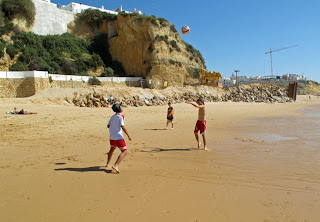




The main focus of our visit to Cordoba was the very large mosque in the middle of the city.
Cordoba is an ancient city settled well before the birth of Christ but with an official "birth" around 152 BCE. The Romans conquered the city in 575 AD, followed by the Visigoths for period before the Moors took over in 711. During a period of 100 to 200 years the city, ruled by the Muslims, Muslims Christians and Jews lived peacefully while the city prospered and grew.
In 785 the Muslims began construction of a mosque on a site that is thought to have the location of a Roman temple then a Visigoth church. In any case, the mosque they created on this site, and apparently the only mosque that remains in Spain, is extremely large, the biggest in the world it is said. The size quoted is 175 meters by 128 meters (22,400 square meters) or about as big as two Canadian football fields.
It is considered by some to the "most important Muslim monument in the western world, though there are those who say the same about The Alhambra.
In 1236 the city was taken by the Christians and the mosque was declared a Christian monument called Cathedral do Santa Marie Madre de Dios. But the new Archbishop was apparently not happy with the Muslim style temple so ordered the construction of a more traditional Christian cathedral inside the mosque. This created a bit of a stir with some very opposed to such serious modification of this unparalleled structure. In spite of the opposition the Archbishop pressed on with the approval of the Christian King, who had not yet seen the mosque. After the Christian cathedral was well under construction, or possibly completed, the King finally decided to see for himself. When he saw the mosque and what had been done he was apparently not pleased and is quoted to have said, "You have destroyed what cannot be found anywhere else and built something that can be seen anywhere".
Inside, the mosque is overwhelming in size with red and white arches seemingly everywhere. It is so huge that the cathedral, while not unnoticed, occupies only a portion of the mosque. A great deal of effort seems to have been made to integrate/merge the two very different decorative characteristics, some of which I have attempted to show in some of the photos. A note about the photos - it is very dark and the lighting patterns vary so, without a tripod it is difficult to get clear and accurate photographs. Hence the variation in color and light.
The photos are the wall around the mosque including the Tower for calling the faithful to pray, the Christian cathedral inside the mosque, the arches inside the mosque and a couple showing the integration of Muslim and Christian architecture.
As I mentioned in an earlier posting, if you have seen the documentary, "When the Moors Ruled Europe", you will have seen and heard much more about this mosque.
It is very impressive, but for my taste, does not match the Alhambra.
There is a bit more about the visit to Cordoba in a future post.







































